Unit 3
Fluid Power Control
“Direction Control Valves are the valves which determine the path through which a fluid transverses a given circuit.”
The function of a DCV is to control the direction of fluid flow in any hydraulic system.
A DCV does this by changing the position of internal movable parts.
DCV is mainly required for the following purposes:
3.1.1 Classification of DCV
Classification of DCV’s based Fluid Path
Classification of DCVs based on Design Characteristics
Classification of DCVs based on the Control Method
A valve is actuated directly on the valve spool. This is suitable for small-sized valves.
A valve is actuated by a pilot line or using a solenoid or by the combination of electrohydraulic and electro-pneumatic means. The use of solenoid reduces the size of the valve. This is suitable for large-sized valves.
Classification of DCVs based on the Construction of Internal Moving Parts
In this type, the spool is rotated to change the direction of the fluid. It has longitudinal grooves. The rotary spools are usually manually operated.
This consists of a specially shaped spool and a means of positioning the spool. The spool is fitted with precision into the body bore through the longitudinal axis of the valve body. The lands of the spool divide this bore into a series of separate chambers. The ports of the valve body lead into these chambers and the position of the spool determines the nature of interconnection between the ports.
3.1.2 Actuation of DCV
Direction control valves may be actuated by a variety of methods. Actuation is the method of moving the valve element from one position to another.
There are four basic methods of actuation:
Several combinations of actuation are possible using these four basic methods. Graphical symbols of such combinations are given in Table

The simplest DCV is a check valve.
A check valve allows flow in one direction but blocks the flow in the opposite direction.
It is a two-way valve because it contains two ports.
The figure below shows the graphical symbol of a check valve along with its no-flow and free-flow directions.

Fig. Graphical Symbol of Check Valve
There are two main types of check valve:
3.2.1 Ball Type Check Valve

Fig. Ball-type Check Valve
3.2.2 Poppet Type Check Valve

Fig. Poppet type check valve: open and closed position
3.2.3 Pilot operated Check Valve

Fig. pilot operated check valve
A shuttle valve allows two alternate flow sources to be connected in a one-branch circuit.
The valve has two inlets P1 and P2 and one outlet A. Outlet A receives flow from an inlet that is at a higher pressure.
The figure shows the operation of a shuttle valve.

Fig. Shuttle Valve
If the pressure at P1 is greater than that at P2, the ball slides to the right and allows P1 to send flow to outlet A. Fig (a)
If the pressure at P2 is greater than that at P1, the ball slides to the left and P2 supplies flow to outlet A. Fig (b)
A shuttle valve is called an “OR” valve because receiving a pressure input signal from either P1 or P2 causes a pressure output signal to be sent to A.

Fig. Symbol of Shuttle Valve
3.4.1 2/2 DCV (Normally Closed):

Fig. 2/2 DCV (normally closed)
3.4.2 2/2 DCV (Normally Open)
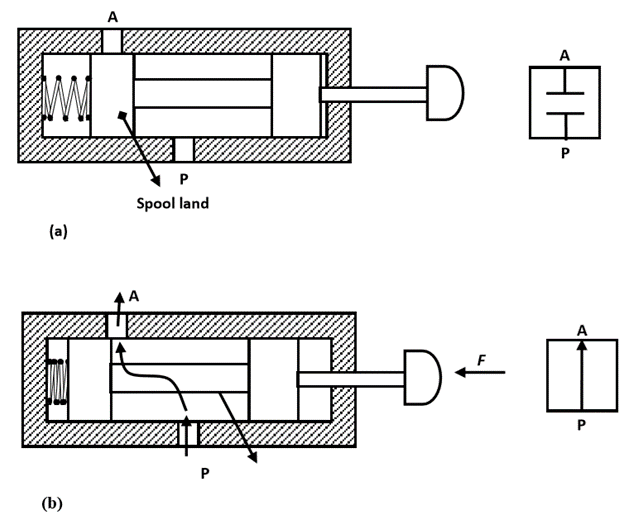
Fig. 2/2 DCV (normally open)
3.4.3 Application of 2/2 DCV

Fig. Application of 2/2 DCV
Three-way valves either block or allow flow from an inlet to an outlet. They also allow the outlet to flow back to the tank when the pump is blocked, while a two-way valve does not.
A three-way valve has three ports, namely, a pressure inlet (P), an outlet to the system (A), and a return to the tank (T).
3.5.1 3/2 DCV (Normally Closed)

Fig. 3/2 DCV (normally closed)
3.5.2 3/2 DCV (Normally Open)

Fig. 3/2 DCV (normally open)
3.5.3 Application of 3/2 DCV (Control of Double Acting Cylinder)
Double-acting cylinders can be controlled with two 3/2-way valves so arranged that when one valve pressurizes one end of the cylinder, the other valve exhausts the other end and vice versa

Fig. Control of Double Acting Cylinder by two 3/2 DCV’s

Fig. 4/2 DCV
3.6.1 Application of 4/2-way valve to control a double-acting cylinder
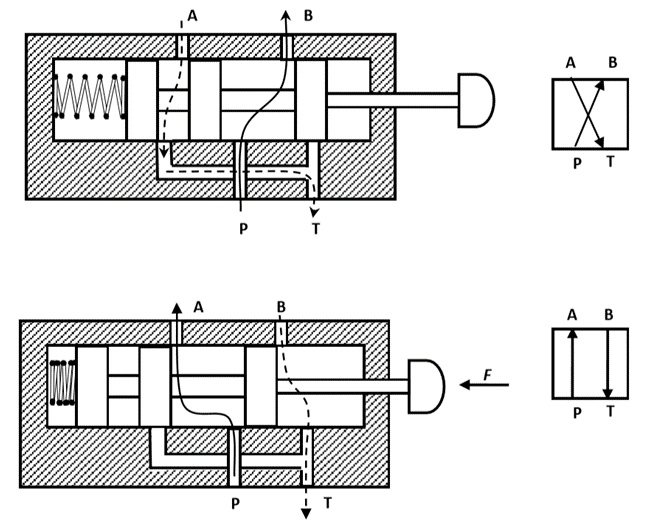
Fig. Control of Double Acting Cylinder by 4/2 DCV
3.6.2 Application of 4/2 DCV for controlling bi-directional motors

Fig. Control of Bidirectional motor with 4/2 DCV
3.6.3 Neutral (Central) positions
Many types of neutrals are available; the most common of them are as follows:
Application of 4/3 DCV (closed neutral) for controlling a double-acting cylinder

Fig. Application of closed neutral position in 4/3 DCV
Application of 4/3 DCV (tandem neutral) for controlling a double-acting cylinder
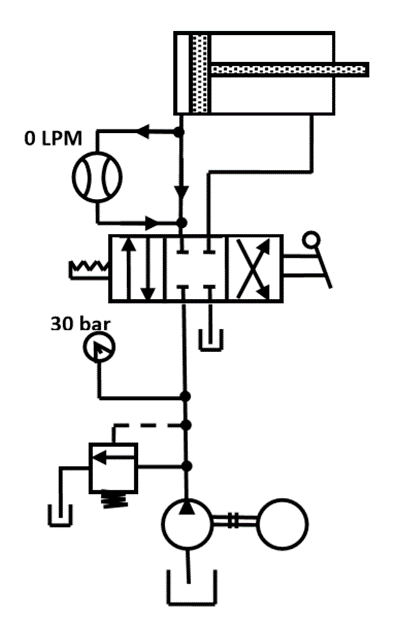
Fig. Application of tandem neutral position in 4/3 DCV
Application of 4/3 DCV (float neutral) for controlling a bidirectional motor

Fig. Application of Float neutral position in 4/3 DCV
Application of 4/3 DCV (open neutral) for controlling a double-acting cylinder

Fig. Application of open neutral position in 4/3 DCV
Application of 4/3 DCV (regenerative neutral) for controlling a double-acting cylinder

Fig. Application of regenerative neutral position in 4/3 DCV



Functions of Flow-Control Valves:
Classification of Flow-Control Valves
Flow-control valves can be classified as follows:
1. Non-pressure compensated.
2. Pressure compensated.
3.7.1 Non-Pressure-Compensated Flow Control Valve
The schematic diagram of the non-pressure-compensated needle-type flow-control valve is shown in Fig.

Fig. Needle-type Non-pressure Compensated Flow Control Valve
(a) Fully Closed (b) Partially Opened (c) Fully Opened
Sometimes needle valves come with an integrated check valve for controlling the flow in one direction only.

Fig. Flow Control Valve with an integrated Check Valve
3.7.2 Pressure Compensated Flow Control Valve
Schematic diagram of a pressure compensated flow-control valve is shown in Fig

Fig. Pressure Compensated Flow Control Valve

Fig. Graphical Symbol of pressure compensated flow control valve
3.7.3 Pressure and Temperature Compensation in Flow Control Valve

Fig. Symbol of Pressure and temperature compensated flow control valve
Pressure-control valves are used in hydraulic systems to control actuator force (force = pressure × area) and to determine and select pressure levels at which certain machine operations must occur.
Pressure controls are mainly used to perform the following system functions:
3.8.1 Pressure Relief Valve
Pressure-relief valves limit the maximum pressure in a hydraulic circuit by providing an alternate path for fluid flow when the pressure reaches a preset level.
A relief valve opens and bypasses fluid when pressure exceeds its setting. The valve then closes again when pressure falls. This means that a relief valve can bypass fluid anytime, or all the time, without intervention by maintenance.
The schematic diagram of the simple relief valve is shown in Fig.

Fig. Simple Pressure Relief Valve
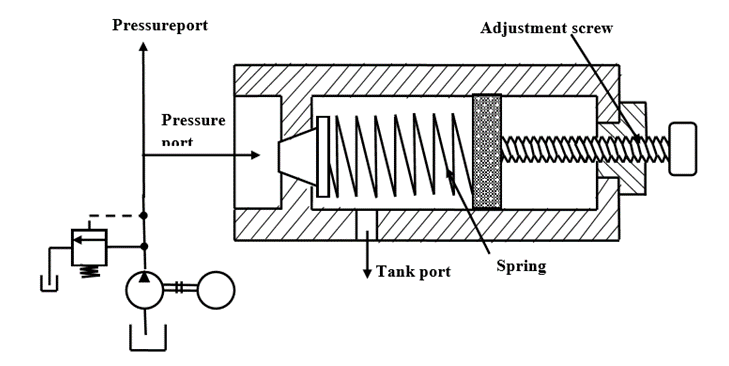
Fig. 3D view of Pressure Relief Valve

Fig. Symbol of Simple Pressure Relief Valve
3.8.2 Compound Pressure Relief Valve (pilot-operated Pressure Relief Valve)
A pilot-operated pressure-relief valve consists of a small pilot relief valve and main relief valve as shown in Fig
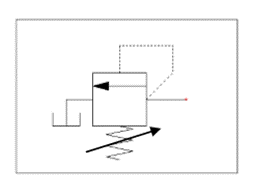
Fig. Compound Pressure Relief Valve
The advantages of pilot-operated pressure-relief valves over direct-acting pressure-relief valves are as follows:
1. Pilot-operated pressure-relief valves are usually smaller than direct-acting pressure-relief valves for the same flow and pressure settings.
2. They have a wider range for the maximum pressure settings than direct-acting pressure relief valves.
3. They can be operated using a remote while direct-acting pressure-relief valves cannot.
3.8.3 Pressure Reducing Valve
This type of valve (which is normally open) is used to maintain reduced pressures in specified locations of hydraulic systems. It is actuated by downstream pressure and tends to close as this pressure reaches the valve setting.
A schematic diagram of the pressure reducing valve is shown in Fig.
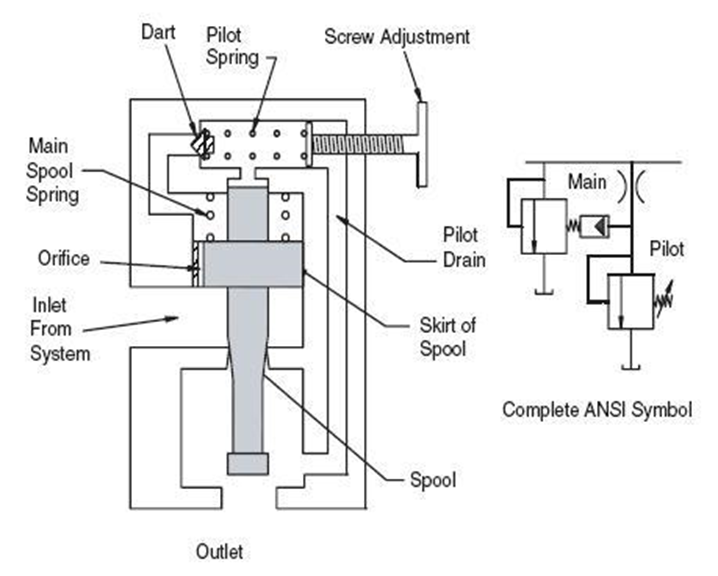
Fig. Pressure Reducing Valve

Fig. Symbol of Pressure Reducing Valve

Fig. 3D view of pressure reducing valve
The figure shows an application for a pressure-reducing valve.

Fig. Application of Pressure Reducing Valve
Here two cylinders are connected in parallel. The circuit is designed to operate at a maximum pressure p1, which is determined by the relief valve setting. This is the maximum pressure at which cylinder 1 operates. By the function of the machine, cylinder2 is limited to pressurep2 (p2<p1).This can be accomplished by placing a pressure-reducing valve in the circuit in the location shown in Fig. 1.9. If the pressure in the cylinder2 circuit rises above p2, the pressure-reducing valve closes partially to create a pressure drop across the valve. The valve then maintains the pressure drop so that the outlet pressure is not allowed to rise above the p2 setting.
3.8.4 Sequence Valve
A sequence valve is a pressure control valve that is used to force two actuators to operate in sequence. They are similar to the pressure-relief valve.
Schematic diagram of the sequence valve is shown in Fig

Fig. Symbol of Sequence Valve

Fig. Sequence Valve
The hydraulic circuit is shown in Fig. below is an example of an application of a sequence valve in which a clamp cylinder extends first to hold a workpiece and then a second cylinder extends to bend the workpiece in the desired shape.

Fig. Application of sequence valve
3.8.5 Unloading Valve
Unloading valves are pressure-control devices that are used to dump excess fluid to the tank at little or no pressure.
Schematic diagram of the unloading valve is shown in Fig

Fig. Unloading Valve
The figure shows the application of the unloading valve in a punching press.

Fig. Application of unloading valve in a punching press
3.8.6 Back Pressure and Counter Balance Valve
Schematic diagram of the counterbalance valve is shown in Fig

Fig. Counterbalance Valve
These normally closed valves are primarily used to maintain a back pressure on a vertical cylinder to prevent it from falling due to gravity. They are used to prevent a load from accelerating uncontrollably. Hence Counter Balance Valve is primarily used as Back Pressure Valve.

Fig. Symbol of the Counterbalance valve
Counterbalance valves are commonly used to counterbalance weight or external force or counteract a weight such as a platen or a press and keep it from freefalling.
The figure illustrates the use of a counterbalance or back-pressure valve to keep a vertically mounted cylinder in the upward position while the pump idles, that is, when the DCV is in its center position. During the downward movement of the cylinder, the counterbalance valve is set to open at slightly above the pressure required to hold the piston up (a check valve does not permit flow in this direction).

Fig. Application of Counterbalance valve
Servo valves are a close relative of the proportional valve and are based on an electrical torque motor which produces a small deflection proportional to the electrical current through its coil. They commonly use feedback between the main and pilot spools to give precise control. A typical device is shown in Figure.
This consists of a small pilot spool connected directly to the torque motor. The pilot spool moves within a sliding sleeve, mechanically linked to the main spool.
The fight-hand end of the main spool is permanently connected to the pilot pressure line, but because of the linkage rod, its area is reduced to an annulus of area A. The pressure at the left-hand end of the spool is controlled by the pilot valve. There is no area restriction at this end, and the valve is designed such that the spool has an area of 2A.
The mechanical linkage between the main spool and pilot sleeve controls the flow of fluid between the pilot valve and main valve, and hence controls the pressure at the left-hand end of the main pool.

Fig. Servo valve
Servo valves are generally used as part of an external control loop in a feedback control system. The principle of a feedback control system is shown in Figure, where some plant variable (velocity or position, for example) is to be controlled. The plant variable is measured by a suitable transducer and electronically compared with the desired value to give an error signal. This is amplified and used as the control signal for the servo valve.

Fig. Feedback Control System

Fig. Poppet type Cartridge Valve
Cartridge valves can be used as follows:
1. Leak-proof direction control valve.
2. Check the valve to obtain unidirectional flow.
3. Throttle valve to control and limit the rate of flow.

Fig. Proportional Control Valve
A brake valve performs the same function as a counterbalance valve, but it is designed to overcome a key disadvantage of hydraulic power loss due to pressure drop across the counterbalance valve.

Fig. Brake Valve
As shown in the functional diagram in Fig. 3.29, a brake valve has an internal pilot passage and a remote pilot passage. Suppose the spring is set for 1000 psi. When the pressure at the internal pilot reaches 1000 psi, the piston pushes the spool upward to open the valve.
The area of the piston is much less than the area of the bottom of the spool. A typical area ratio might be 10:1. The remote pilot applies pressure directly to the bottom of the spool; consequently, only 100 psi is required to compress the spring and open the valve. The pressure required to open the valve is 1000 psi at the internal pilot and 100 psi at the remote pilot.
References :
1. Pipenger J.J, Industrial Hydraulics, McGraw Hill
2. Pinches, Industrial Fluid Power, Prentice Hall
3. Yeaple, Fluid Power Design Handbook
4. Andrew A. Parr, Hydraulics and Pneumatics, Elsevier Science and Technology Books
5. ISO - 1219, Fluid Systems and components, Graphic Symbols
6. Standard Manufacturer’s Catalogues